WHAT IS A TERRARIUM
A terrarium is a contained environment artificially created to mimic the natural environment from which the plants come from in the wild. It is a controlled environment that allows the necessary entrance of natural or artificial light for photosynthesis, and it maintains a relatively humid environment that enables plants to flourish.
THE HISTORY OF TERRARIUMS
Nathaniel Bagshaw Ward was the man credited to the art of growing plants in terrariums. This came about with the publishing of his book called “On the Growth of Plants in Closely Glazed Cases” which he published in 1842.
Nathaniel had wanted to watch an insect chrysalis transform into an insect, and so he placed it in a capped glass bottle. He observed this bottle on a regular basis and noted how, because of the sun, moisture would be drawn to the top of the bottle during the day then circulate back down in the evening. Then quite unexpectedly a seedling fern and a sprout of grass bloomed inside the bottle. He was very surprised by this because he had been unsuccessfully trying to grow these plants in his garden. From this he devised further experiments and the science of the terrarium was born. For a very long time these small glass enclosures were named Wardian Cases after him and even though the term is still in use today it is generally not well known and they are simply called terrariums.
ADVANTAGES OF GROWING CARNIVOROUS PLANTS IN TERRARIUMS
Terrariums are a great way to grow carnivorous plants. The main advantage of growing carnivorous plants in a terrarium is that the plants are grown in a humid environment. This is an important factor in growing carnivorous plants as they thrive on high humidity. It also allows enthusiasts to grow carnivorous plants in geographical locations with extreme environment from what the plants experience in their natural habitat.
A terrarium, if built properly can be a unique showpiece in the home instead of a regular fish tank or picture. It would be both pleasing to the eyes and a discussion topic for family and friends.
If the plants are cleaned properly before they are placed in the terrarium and if the terrarium is maintained well, there will be no problems with pests. No risk of using pesticides.
A terrarium also allows the enthusiasts to control the environment within the tank so that they can adjust the requirements for different species to suit their cultivation needs. Plants can be given as much light for as long as they like so that they will thrive. You are able to control the light intensity and the number of hours your plants receive light.
Most species of carnivorous plants do not like drastic changes in their environment. A terrarium gives them the constant environment variables that they require.
With a terrarium, plants can be grown even if there is limited space, in an apartment where there is no source of natural sunlight or in a geographical location with drastic differences in humidity or temperature levels compared to the habitat of the plants.
PLANNING
Before building a terrarium, the following points needs to be considered:
Location
Decide the location of the terrarium. Make sure there is space and the location is safe so that accidents will not happen. It is exasperating when you do not have space to put the terrarium after you build it or the location is not safe resulting in an accident where the terrarium falls and injure someone. It is also important that the location is not exposed to water or high humidity as the lighting components does not go well with moisture or water. Make sure there is also a power point nearby for the lightings.
Planted or potted
There are basically two ways to setup a terrarium. It can either be a planted landscape with plants planted directly into the landscape or individual pots of plants placed in the terrarium.
The planted terrarium can be a very spectacular and eye catching display if done properly. The general structure and layout of the plant is important. Aesthetic appeal and design principals are also important. These principals are balance, contrast, dominance, proportion, rhythm and scale. Do not select plants that are of the same size and color. A general rule of thumb is to use an odd number of plants like 3, 5, 7, or 9. Planted terrariums are a little more difficult to maintain if compared to potted terrariums. Vigorous species such as Utricularia and some species of Drosera will spread throughout the landscape like weeds overcrowding other species. If one plant is sick or attack by pest, it cannot be isolate and treated.
The potted setting can also look great if the plants are arranged neatly. I personally prefer this form of layout as it is easier to maintain. If you have a few terrariums, it can become a chore to clean them. Sick or pest infected plants can be taken out so that the disease or pest does not spread to the rest of the plants in the terrarium. Various species of carnivorous plants with different media and water requirement can be grown together as they are individually potted.
Species
The species of plants that you plan to grow would influence the design of your terrarium to a certain extent. Therefore, think though carefully what you want to grow in the terrarium before designing it. Example… if you are thinking about growing Sarracenia, you would need to have a higher terrarium to accommodate the height of the plants and you might need to think about using high intensity lightings. If you would like to grow Drosera, then the lightings need to be very close to the plants, etc, etc…
You will also need to decide whether you want to grow highland plants or lowland plants in the terrarium. If you are growing highland carnivorous plants, you will need some sort of air conditioner or chiller to chill the air in the terrarium and bring the temperature down. It is easier and cheaper to heat up a tank for lowland plants in a cold climate rather than cooling the tank in a hot climate.
BUILDING
There are two very important points to take note when growing carnivorous plants in a terrarium. These variables are light and heat. Give them enough light and make sure temperature in the terrarium does not fry the plants. You can add more light bulbs to increase light intensity but this also means temperatures will rise. Make sure that the temperature does not rise too high. In the small confined environment such as the terrarium, it can get pretty hot.
There is no fix design that must be followed when designing or building a terrarium. You can be as creative as you wish. Just consider the pointers in this article before building the terrarium.
Light
Lighting is an important variable when building a terrarium. If the lighting is insufficient, the light spectrum or Kelvin is not right; the plants will not grow well. Even though they are carnivorous, they need light for photosynthesis to produce food for growth. Without light, all plants will eventually die. My “pets” are given 14-16 hours of light each day. It is advisable to buy a good timer so that you do not have to switch the lights on and off everyday. It can be quite a dread after a while and if you are away on holidays, you won’t be able to switch it off.
Terrarium growers use florescent tubes, PLL, PLC, T5 or Metal halide lightings for their terrarium. However, please note that in selecting lightings such as florescent tubes, PLL and PLC, make sure the Kelvin is 6500k. If in doubt just use T5. Please also be aware that Metal halide produces a lot of heat. So it is not a good idea to set up a terrarium with Metal halide lightings in a small enclose room. The room will get very hot and uncomfortable for you and most the set up will fry your plants. The aim is to provide as much light as possible without frying the plants.
The distance between the plants and the lightings is also important. The nearer the lights are to the plants the more effective it would be. However, this also means that the plants would not have much space to grow and it would be hotter for the plants. It is best to keep a maximum of 8 inches between the lights and plants. For the species Drosera and Dionaea muscipula that requires intense sunlight, it is best to place them just below the lightings. If you are growing Sarracenia with their tall pitchers, it is advisable to use Metal halide as the lights are more intense and can be placed further away from the plants.
It is also important to note that the light intensity from artificial lightings decreases over time. Usually florescent light intensity decreases after 6 months and will need to be changed. However, if you use better quality lightings like T5, PLL, PLC and Metal halide, the light intensity will be maintained for a longer period for about 12-18 months.
Heat
Heat is the second most important variable to consider when building a successful terrarium. This is especially important for enthusiasts living near to the equator where the air is naturally warm. Heat from lightings can increase the temperature in a small enclose area significantly if measures are not taken to control or remove it. One way to do this is to have a small gap between the glass panel of the terrarium and the lighting. This is to allow air flow. Use computer fans to blow across the empty space between the terrarium and the lighting to remove heat generated from the lightings. If you are using light fixtures with ballast, it is important to have a computer fan blow across the ballast. The ballast is a hottest part in the lighting fixture. If you have a choice, use electronic ballast that does not produce heat.
It is good practice to get a thermometer to monitor the temperature in the terrarium. Most species of carnivorous plants do well in temperatures of 25-31 degrees Celsius (77-87.8 degrees Fahrenheit). Do not allow the temperature to rise above 35 degrees Celsius (95 degrees Fahrenheit). However, highland or temperate species require cooler conditions. To achive the cool environment that they require, some sort of chiller or air-conditioner needs to be installed into the terrarium.
Airflow and humidity
It is best to buy a hygrometer to measure relative humidity in the terrarium. Most carnivorous plants thrive in relative humidity of around 50%-60% during the day and 80%-90% during the night.
One point to note is that carnivorous plants grown in a very humid environment will become “soft”. Plants in a terrarium grow faster than plants grown in the garden. In a humid environment, the plant puts more energy into growth and less into protective mechanisms. Therefore, when they are exposed to low humidity, they will often wilt. What I do is I leave a gap so that the terrarium does not get too humid. If water condenses on the glass of your Terrarium, it means that the humidity is too high. The gap allows air circulation and helps prevent fungus growth.
If low humidity is a problem, fill up the terrarium with 2-3 inches of water. Place the plants above the water line. I use plastic drain covers with PVC pipes as the support stand. Place an aquarium air pump with the air hose and air stone in the water. When air is pumped into the terrarium, the air bubbles break the water surface. This process creates humidity in the terrarium. Air flows from the bottom to the top and out of the tank. This process helps exchange hot air created from the lighting with cool outside air.

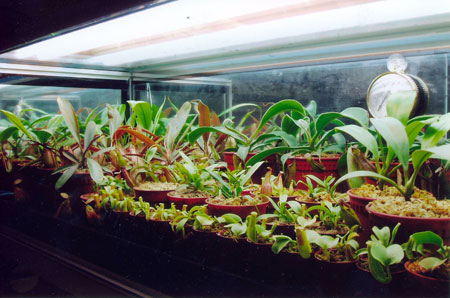
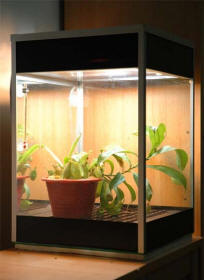

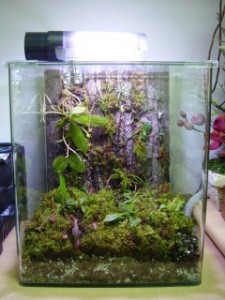
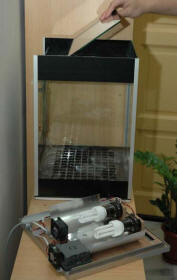

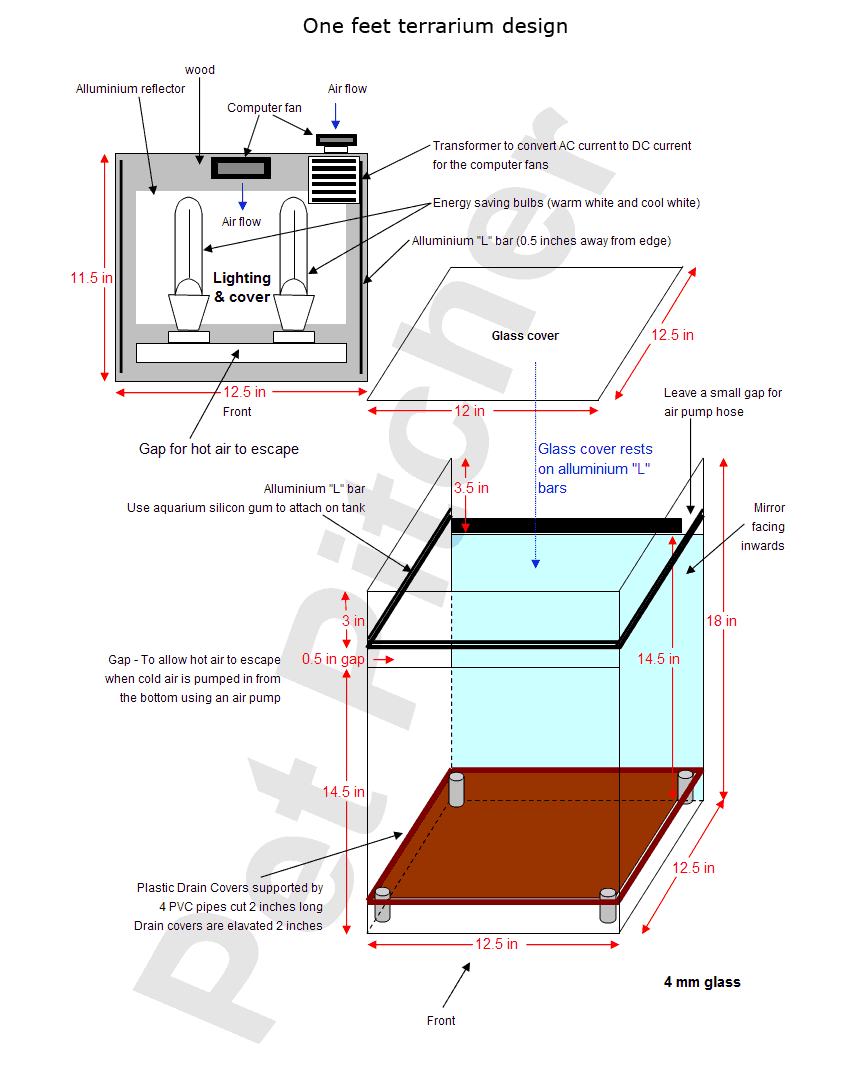

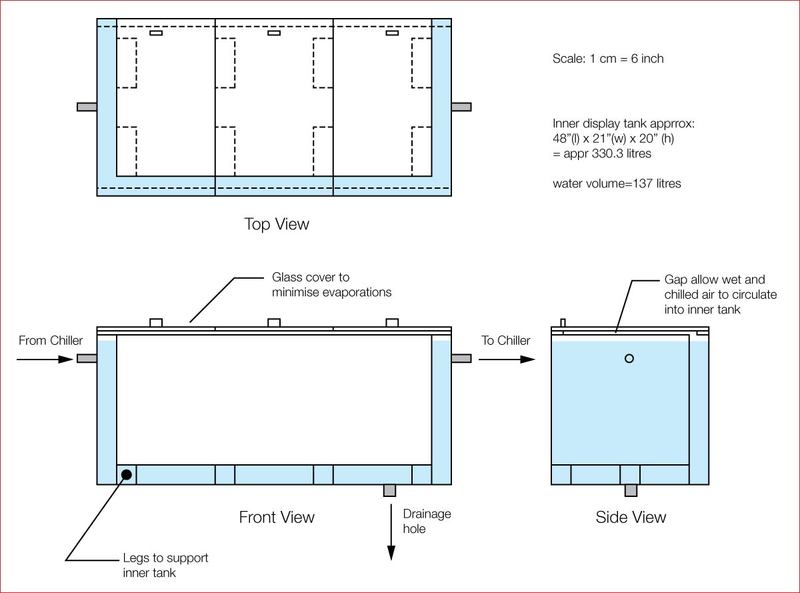
lovely!
Comment by lamde83 — August 31, 2009 @ 12:09 am
Thanks lamde83
Comment by David — September 1, 2009 @ 11:15 am
I’m going to try this
Comment by alagesm — October 7, 2009 @ 10:08 am